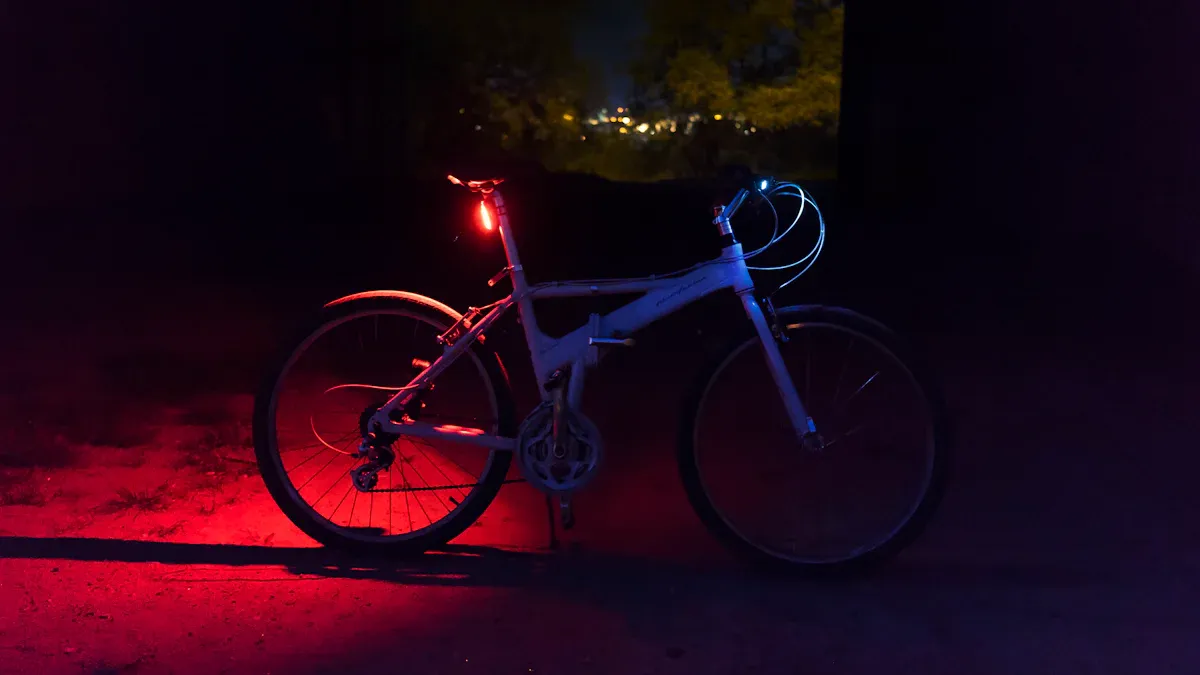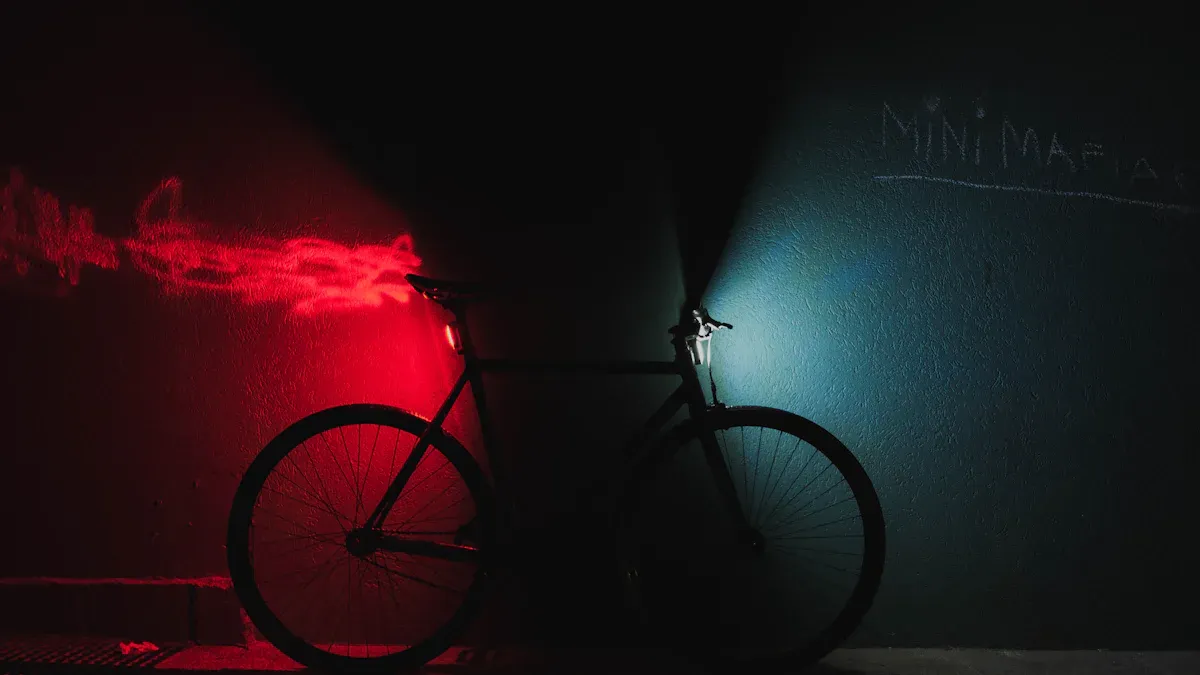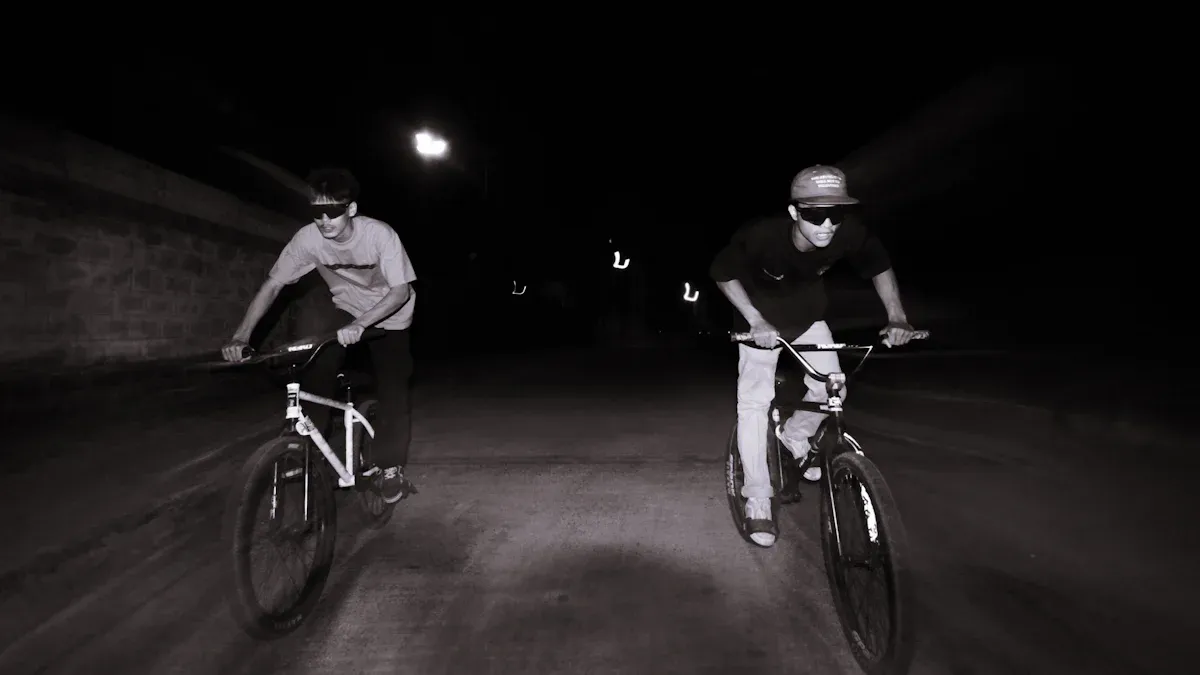headlamps vs bikelights for cycling outdoors at night

When you're cycling at night, choosing the right lighting can make all the difference. Should you go for a headlamp or a bikelight? It depends on what matters most to you. Are you looking for something lightweight, durable, or easy to charge? Here's a quick look at some common factors cyclists consider:
Factor | Description |
|---|---|
Weight & size | Compact lights are ideal for urban commuting, while larger lights suit off-road biking. |
Durability | Essential for rough conditions; materials should withstand impact and weather. |
Ease of charging | USB-rechargeable lights are convenient for daily use. |
Whether you're navigating city streets or rugged trails, the right choice ensures safety and comfort. Some cyclists even explore versatile options like the helius flashlight for added convenience.
Key Takeaways
Headlamps shine light where you look, great for rough trails. They help you see clearly on bumpy paths.
Bikelights light up the road ahead and make you visible. They are great for city rides, helping cars and people see you.
Think about weight and comfort when picking your lights. Bikelights are lighter for long rides, but heavy headlamps can hurt.
Pick lights based on where you ride. Headlamps work well in dark, rough places. Bikelights are better for bright city streets.
Headlamps are useful for other outdoor activities too. They are a smart choice for adventurers.
Visibility and Illumination

Headlamps
Directional lighting for where the cyclist is looking
Headlamps are like having a flashlight strapped to your head. They shine light exactly where you're looking, which is super helpful when you're scanning for obstacles or navigating tricky paths. This directional lighting gives you more control over what you see, especially in areas with no streetlights. Whether you're turning your head to check a corner or focusing on a specific spot, a headlamp ensures the light follows your gaze.
Ideal for off-road or trail cycling
If you're into off-road adventures, headlamps are a game-changer. Trails often have uneven terrain, sudden turns, or unexpected obstacles like rocks or roots. A headlamp's ability to focus light on where you're looking makes it perfect for these situations. Plus, many headlamps offer adjustable beam patterns. A narrow beam works great for spotting distant objects on unlit paths, while a wider beam helps illuminate a larger area, which is handy for gravel or forest trails.
Bikelights
Mounted on the bike for consistent forward illumination
Bikelights are mounted directly on your bike, usually on the handlebars or frame. This setup provides steady, forward-facing illumination, so you don't have to worry about adjusting the light as you ride. It's like having a car's headlights for your bike. This consistency is especially useful when you're riding on straight roads or in urban areas with some ambient lighting.
Enhances visibility to other road users
In cities, bikelights do more than just light up the road ahead. They make you visible to drivers, pedestrians, and other cyclists. This is crucial for staying safe in traffic. Many bikelights come with multiple modes, like flashing or steady beams, so you can adjust your visibility based on the environment. For daytime urban rides, a light with at least 300 lumens is recommended. At night or in rural areas, you'll need something brighter—around 700 to 1000 lumens—to ensure you're seen and can see clearly.
Tip: A good bikelight not only helps you see but also ensures others can see you, reducing the risk of accidents.
Comparison
Brightness and beam spread differences
Headlamps and bikelights differ in how they spread light. Headlamps often have adjustable beams. A wide beam is great for city rides, while a narrow one is better for focusing on distant spots during trail rides. On the other hand, bikelights are designed for consistent forward illumination, making them ideal for urban commuting or road cycling. They also tend to be brighter, with higher lumen counts, to ensure visibility in various conditions.
Effectiveness in urban vs. off-road conditions
Your choice depends on where you're riding. Headlamps excel in off-road conditions, where you need to see exactly where you're looking. They're perfect for trails, gravel paths, or unlit country roads. Bikelights, however, shine in urban settings. They not only light up the road but also make you more visible to others, which is essential for navigating busy streets safely.
Whether you're tackling rugged trails or cruising through the city, understanding the strengths of each option helps you make the best choice for your ride.
Comfort and Ease of Use
Headlamps
Comfort of wearing on the head or helmet
Wearing a headlamp can feel convenient since it keeps your hands free and the light always follows your gaze. However, comfort depends on the design. Lightweight headlamps with adjustable straps fit snugly without causing pressure points. If you wear a helmet, some headlamps come with clips or mounts to attach securely. This setup works well for trail riders who need flexibility.
That said, not all headlamps are created equal. Heavier models can feel bulky, especially during long rides. If the straps aren’t adjustable enough, they might slip or feel too tight, which can get annoying. You’ll want to pick one that balances weight and comfort for your needs.
Potential weight and adjustability concerns
Weight plays a big role in how comfortable a headlamp feels. A heavier headlamp can strain your neck over time, especially on bumpy trails. Adjustability is another factor to consider. Straps that don’t fit properly can shift during your ride, forcing you to stop and readjust. Look for headlamps with ergonomic designs and lightweight materials to avoid these issues.
Bikelights
Easy to mount and stable during rides
Bikelights are designed for simplicity. Most models use handlebar mounts, which are easy to install and keep the light stable. Some even feature quick-release mounts, so you can switch them between bikes without tools. If you prefer extra stability, clamp-style mounts attach firmly to the handlebars, ensuring the light stays in place even on rough terrain.
For added versatility, helmet-mounted lights give you directional control, while seat post mounts are perfect for rear lights. These options make bikelights adaptable to different riding styles and conditions.
No physical burden on the cyclist
Unlike headlamps, bikelights don’t add any weight to your body. Once mounted, they stay out of your way, letting you focus on the ride. This makes them a great choice for long-distance cyclists who want to avoid discomfort or fatigue caused by carrying extra gear.
Comparison
User comfort during long rides
When it comes to long rides, bikelights win in terms of comfort. They don’t weigh you down or require adjustments mid-ride. Headlamps, while useful, can become uncomfortable if they’re too heavy or poorly fitted. If you’re planning a multi-hour ride, you’ll likely appreciate the hands-free ease of a bikelight.
Convenience of use and adjustments
Bikelights are easier to manage overall. Handlebar-mounted lights stay secure and require minimal adjustments. Quick-release mounts make them easy to remove for charging or switching bikes. Headlamps, on the other hand, need more frequent adjustments to stay comfortable and aligned. If convenience is your priority, bikelights are the way to go.
Tip: For the best experience, choose a lighting option that matches your riding style and comfort preferences.
Practicality and Versatility
Headlamps
Versatility for off-bike activities
Headlamps aren't just for cycling. They’re incredibly versatile and can be used for a variety of outdoor activities. Imagine needing hands-free light while setting up a tent, cooking, or reading a map in the dark. A headlamp makes all of that easier. It’s also great for safety during nighttime hikes or stargazing. You can even use it for precise tasks like examining gear or navigating tricky terrain.
Here are some other ways headlamps come in handy:
Perfect for emergency situations when power is out.
Great for nighttime adventures like wildlife photography.
Long-lasting batteries make them reliable for extended trips.
Creates a cozy light for reading or organizing gear inside a tent.
If you enjoy outdoor activities beyond cycling, a headlamp is a must-have.
Portability and multi-purpose use
Headlamps are lightweight and easy to carry, making them ideal for multi-purpose use. You can toss one in your backpack, and it’s ready for anything. Whether you’re hiking, camping, or even just walking your dog at night, a headlamp provides reliable illumination. Some models even come with adjustable straps or mounts, so you can switch between wearing it on your head or attaching it to your bike. This flexibility makes headlamps a practical choice for adventurers like you.
Bikelights
Designed specifically for cycling
Bikelights are built with cyclists in mind. They’re designed to keep you safe and visible on the road. Here’s what makes them stand out:
Beam Patterns: Wide beams for urban areas and narrow beams for rural roads.
Light Placement: Front lights illuminate the path ahead, while rear lights make you visible from behind.
Power Supply Options: Rechargeable or replaceable batteries to suit your needs.
Durability: High-quality materials ensure they can handle rough rides.
Waterproofing: Many bikelights are rated to withstand rain or splashes.
These features make bikelights a reliable companion for your cycling adventures.
Features like rechargeable batteries and waterproofing
Rechargeable batteries make bikelights super convenient. You can easily charge them via USB, saving money and reducing waste. Plus, they’re built to last. Durable materials and waterproof designs mean your bikelight can handle unexpected rain or bumpy trails. Whether you’re commuting in the city or exploring the countryside, these features ensure your light stays functional.
Comparison
Practicality for cycling-specific needs
If your main focus is cycling, bikelights are the way to go. They’re designed to meet the specific needs of cyclists, from beam patterns to battery options. They also comply with safety regulations, ensuring you’re visible to others on the road. For urban commutes or long-distance rides, bikelights provide the practicality you need.
Versatility for other outdoor activities
Headlamps win when it comes to versatility. They’re not limited to cycling and can be used for hiking, camping, or even emergency situations. Their hands-free design makes them perfect for tasks that require both hands, like setting up camp or cooking. While bikelights are specialized for cycling, headlamps adapt to a wider range of activities, making them a more flexible option for outdoor enthusiasts.
Tip: If you’re looking for a light that works both on and off the bike, a headlamp might be your best bet. But if cycling is your main activity, a bikelight offers unmatched practicality.
Best Use Cases
When to Choose a Headlamp
Off-road cycling or trails
Headlamps shine when you're tackling off-road trails or rugged terrain. Their directional lighting helps you focus on specific areas, which is essential for navigating uneven paths or spotting obstacles like rocks and roots. Since they’re hands-free, you can concentrate on steering or adjusting your gear without worrying about holding a flashlight.
They provide focused illumination, perfect for tricky terrain.
Red light or dimming features preserve your night vision, keeping you aware of your surroundings.
Their versatility makes them useful for other outdoor activities, like hiking or camping.
If you're cycling in low-light conditions, a headlamp also enhances your visibility to others, adding an extra layer of safety. Whether you're exploring forest trails or gravel paths, a headlamp ensures you’re prepared for the unexpected.
Situations requiring directional lighting
Sometimes, you need light exactly where you're looking. That’s where headlamps excel. They’re perfect for tasks that require precision, like moving brush aside or checking your bike for issues.
Tip: A headlamp is also handy for off-bike activities. Use it for setting up camp, cooking, or even reading a map in the dark. Its hands-free design makes multitasking a breeze.
When to Choose a Bikelight
Urban commuting or road cycling
Bikelights are your best friend for city rides or road cycling. They’re designed to keep you visible and safe in traffic. Many models offer multiple modes, like steady beams for lighting up the road and flashing modes to grab the attention of drivers.
For city commutes, pick a wide beam light with high lumens (250-800).
On country roads, go for a narrower beam with more throw to see farther ahead.
A compact, lightweight bikelight won’t interfere with your bike’s handling, making it ideal for navigating crowded streets. Pair it with a bright rear tail light (100-200 lumens) for added safety.
Scenarios requiring consistent forward illumination
When you’re riding on straight roads or in urban areas, consistent forward lighting is key. Bikelights mounted on your handlebars provide steady illumination, so you can focus on the ride without adjusting the light.
Wide beam patterns help detect obstacles in city streets.
Flashing rear lights increase visibility to drivers during the day.
Note: A bikelight not only lights your path but also ensures others see you, reducing the risk of accidents. It’s a must-have for urban cyclists who prioritize safety and convenience.
Exploring the Helius Flashlight for Night Cycling

Features of the Helius Flashlight
Brightness and beam spread
The Helius Flashlight stands out with its impressive brightness and unique beam profile. It uses a single XHP35 HD LED, which delivers powerful illumination. Unlike other cycling lights that rely on XPL HI LEDs, the Helius has a smaller reflector. This design creates a beam spread that’s slightly different from what you might find in other lights.
The Helius offers a bright, focused beam, perfect for spotting obstacles ahead.
Its beam profile ensures you get a balance of distance and width, making it versatile for various terrains.
Whether you're cycling through dark trails or dimly lit streets, the Helius Flashlight ensures you see clearly and stay safe.
Rechargeable and waterproof design
You’ll love the practicality of the Helius Flashlight. It features a rechargeable battery, so you don’t have to worry about constantly replacing batteries. Just plug it in, and you’re good to go. Plus, it’s rated IPX5 for water resistance. This means it can handle rainy rides or splashes without any issues.
Tip: A rechargeable and waterproof flashlight like the Helius is a reliable companion for all your night cycling adventures.
Comparing the Helius Flashlight to Headlamps and Bikelights
Versatility for cycling and other activities
The Helius Flashlight isn’t just for cycling. Its compact design and powerful beam make it suitable for a variety of activities. You can use it for hiking, camping, or even as an emergency light. Unlike bikelights, which are fixed to your bike, the Helius can be carried or mounted, giving you more flexibility.
Use it as a handheld light for off-bike tasks.
Mount it on your bike for consistent forward illumination.
Take it along for outdoor adventures beyond cycling.
This versatility makes the Helius Flashlight a great choice if you want a multi-purpose tool.
Practicality for different cycling scenarios
The Helius Flashlight adapts to your cycling needs with its three light modes: high, low, and strobe. The high mode provides maximum brightness, perfect for dark trails or rural roads. The low mode conserves battery while still offering enough light for daytime rides. The strobe mode enhances your visibility, making it ideal for urban cycling or alerting others in emergencies.
Visibility range of 300-500 meters ensures safety during night rides.
Water resistance and durable design make it reliable in wet or rough conditions.
Whether you’re commuting in the city or exploring off-road trails, the Helius Flashlight has you covered.
Choosing between a headlamp and a bikelight depends on your cycling habits and environment. Each option offers unique benefits, so understanding your needs is key.
For urban cycling, a front light with 200-500 lumens works well. Off-road riders should aim for over 800 lumens to handle rough terrain.
Tail lights between 50-200 lumens improve visibility to others, especially in low-light conditions.
Look for lights with multiple modes, like steady and flashing, to adapt to different scenarios.
Using the wrong lighting can reduce visibility and increase accident risks. Balancing brightness, comfort, and practicality ensures a safer, more enjoyable ride.
FAQ
1. Can I use both a headlamp and a bikelight together?
Absolutely! Combining both gives you the best of both worlds. A headlamp helps you see where you're looking, while a bikelight ensures consistent forward illumination. This setup is especially useful for off-road trails or poorly lit areas.
2. How bright should my bike light be for night cycling?
For urban cycling, aim for 200-500 lumens. Off-road or rural rides need brighter lights, around 800-1000 lumens. Don’t forget a rear light with 50-200 lumens to stay visible to others.
Tip: Choose a light with adjustable brightness to adapt to different conditions.
3. Are rechargeable lights better than battery-powered ones?
Rechargeable lights are more convenient and eco-friendly. You can charge them via USB, saving money on batteries. However, battery-powered lights can be handy for long trips where charging isn’t an option.
4. Do I need waterproof lights for cycling?
Yes, waterproof lights are essential. They ensure your lights work during unexpected rain or wet conditions. Look for lights with an IPX4 rating or higher for reliable performance.
5. Can I use a headlamp without a helmet?
You can, but it’s less stable. Headlamps work best when mounted on a helmet or securely strapped to your head. This keeps the light steady and aligned with your line of sight.
Note: If you don’t wear a helmet, choose a headlamp with adjustable straps for a snug fit.
See Also
Choosing Between Lanterns And Flashlights For Camping Fun
Key Factors To Think About When Buying A Headlamp
Enjoy Night Fishing With A Convenient Headlamp Flashlight
Effective Ways To Use The CYANSKY HS6R Headlamp Outdoors
Must-Have Headlamps For Convenient Hands-Free Lighting Solutions
